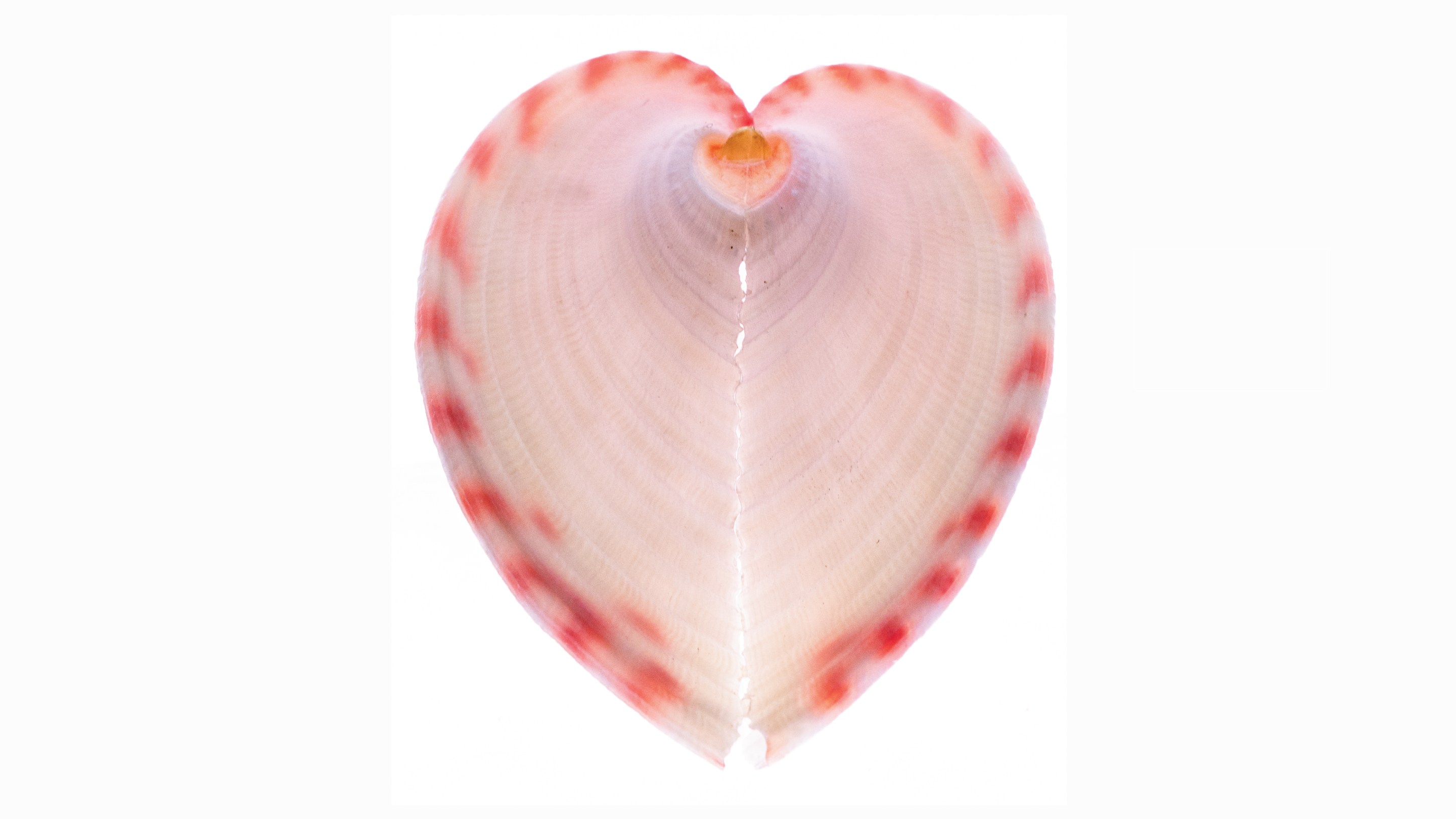Imagine, if you would, that a clam was a church. Most of the walls are thick and opaque, protecting the animal's soft insides. But in certain clams called heart cockles, pricks of sunlight stream through the top shell like stained glass, illuminating the tiny organisms dwelling inside the clam. When Dakota McCoy, a biophysicist at the University of Chicago, first shone a light through the upper shell of a heart cockle, she was struck by this comparison. "Once I lit up that beautiful pinkish shell, I immediately thought, I've seen this before in the U Chicago chapel," McCoy wrote in an email.
The cockle Corculum cardissa is best known for its profile—the two shells come together to form a heart shape. But McCoy was most intrigued by the clam's celestial skylights, which let in sunlight to sustain the microscopic algae that live inside the mollusk's tissue. McCoy and colleagues recently published a paper in Nature Communications describing how these windows manage to act like fiber optic cables that beam in the good light and keep out the bad, long before any human engineer cracked the code.

When McCoy was finishing her PhD at Stanford University, she became enamored with what she saw as the paradox of heart cockles. She knew that corals, like the cockles, live in a symbiosis with photosynthetic algae. But while reef-building corals can bleach bone-white with just one degree of global warming, heart cockles have proven far more resistant. "What on earth is going on?" McCoy asked herself.
At a glance, photosynthetic algae seems a strange roommate for a creature like a clam, whose living body is entirely enclosed in the darkness of a shell. "You need to provide a way of getting the light to the microorganism," said Sönke Johnsen, a sensory biologist and biophysicist at Duke University and an author of the paper. A slew of clams have solved this problem rather simply. Giant clams, which also have single-celled algae dwelling in their tissues, open their shell in a perpetual, sun-soaked yawn. The basket cockle and white strawberry cockle temporarily gape their shells, and in some cases can wrap their soft tissue over their shells. But the heart cockle's solution to this problem does not require leaving the house, only letting the light in.

McCoy wanted to collect heart cockles from the wild in Palau. "But several hours of snorkeling face down in shallow [one-foot] water led to nothing," she said. Instead, she sourced specimens from a museum and a seashell collectors' website and sent them to a laser optics lab to be polished. McCoy and Jennifer Dionne, a materials scientist at Stanford and an author on the paper, measured the transmission of light through the shell's windows. The optical and electron microscopes in Dionne's lab only worked on small or flat surfaces, Dionne wrote in an email. The shells' crystal structures made them difficult to break apart in even pieces, so McCoy borrowed a rock saw to dice the shells.
Before the experiments, the researchers assumed all these windows were arranged in a triangular shape. "But once we started looking carefully we realized there is a massive, beautiful diversity," McCoy said. They found windows repeating in radial stripes and in mosaics. Each clam was a cathedral of its own, with intricate patterns of translucence.

Under microscopy, much of a heart cockle's shell is made of plates of aragonite, a calcium carbonate mineral, stacked atop each other like bricks. But to make windows, the clamshell opts instead for bundles of long fibers arranged perpendicular to the shell and parallel to the direction of sunlight. Surprisingly, these structures act just like fiber optic cables—strands of glass that are thinner than human hair and can carry data in the form of light waves. "The heart cockles are the first organism I am aware of that has natural fiber optic bundles," Dionne said.
The precise size, shape, and arrangement of these bundled crystals allow the heart cockles to be choosy about their light. The researchers' measurements revealed that the cockles let in light in red and blue ranges, which is the best light for photosynthesis. This arrangement also blocks harmful UV radiation from reaching the soft tissue inside. "It's like a totally different kind of sunblock," McCoy said, adding that these structures could help explain why cockles are anecdotally more resistant to global warming than corals.
The cockles' fiber crystals are so tightly bundled together that they also act as a lens to direct a concentrated beam of sunlight to the photosynthetic algae within the clam's tissues. And, like artificial fiber optic bundles, they can transmit high-resolution images. The researchers tested this projection ability by focusing on an image on a microscope stand and placing the shell on top of that image. "I made a little mark with a pen on the bottom of the shell, and like an optical illusion, it immediately looked like I had marked the TOP of the shell since it projected the mark through," McCoy said.

Experts who were not involved with the paper told Science News they hoped to design enhanced communication tools based on the architecture of the heart cockles. Dionne believes the clam's architecture might help researchers design better systems to sustainably synthesize chemicals, using manufacturing methods that rely on sunlight. And the authors of the paper hope to continue studying how the clams manage to build such crystalline structures. McCoy is still awed by the diverse patterns of the cockles' skylights. "That raises a real mystery," she said. "Why are they so variable?"
To Johnsen, the image of a clam as a living cathedral stuck with him throughout the research, in part because he tried to imagine himself as an algal parishioner. "Imagine if you were sitting inside this hard cockle, and these beams of light were coming through these windows, like shafts of light through stained glass," he said. While much of human technology relies on special materials such as steel or glasses developed with a high refractive index, nature works with more limited chemicals, Johnsen said. But nature is an incredible builder, especially on a miniature scale. "These animals are making Notre Dame on smaller than your pinky nail," he said






